Home > Travel Information
Kiyomizudera Temple
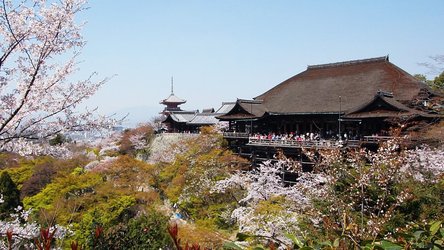
Kiyomizudera (清水寺,
literally "Pure Water Temple") is one of the most
celebrated temples of Japan. It was founded in 780 on
the site of the Otowa Waterfall in the wooded hills east
of Kyoto and derives its name from the fall's waters.
The temple was originally associated with the Hosso
sect, one of the oldest schools within Japanese
Buddhism, but formed its own Kita Hosso sect in 1965. In
1994, the temple was added to the list of World Heritage
Sites.
Kiyomizudera is best known for its wooden stage that
juts out from its main hall, 13 meters above the
hillside. The stage affords nice views of the numerous
cherry and maple trees below that erupt in a sea of
color in spring and fall, as well as of the city of
Kyoto in the distance. The main hall, which together
with the stage was built without the use of nails,
houses the temple's primary object of worship, a small
statue of the eleven faced, thousand armed Kannon.
Higashiyama District
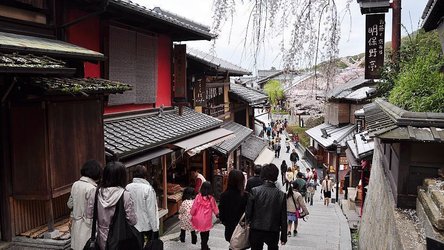
The
Higashiyama District (東山) along the lower slopes of
Kyoto's eastern mountains is one of the city's best
preserved historic districts. It is a great place to
experience traditional old Kyoto, especially between
Kiyomizudera and Yasaka Shrine, where the narrow lanes,
wooden buildings and traditional merchant shops invoke a
feeling of the old capital city.
The streets in Higashiyama are lined by small shops,
cafes and restaurants which have been catering to
tourists and pilgrims for centuries. These businesses
retain their traditional design, although many have been
renovated through the years, and they continue to serve
customers today, selling local specialties such as
pottery, sweets, pickles, crafts and other souvenirs.
Fushimi Inari Shrine
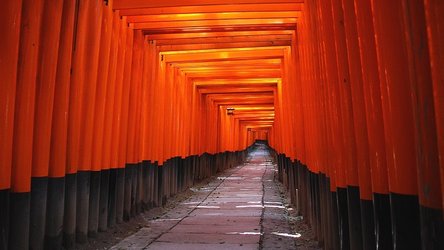
Fushimi Inari
Shrine (伏見稲荷大社, Fushimi Inari Taisha) is an important
Shinto shrine in southern Kyoto. It is famous for its
thousands of vermilion torii gates, which straddle a
network of trails behind its main buildings. The trails
lead into the wooded forest of the sacred Mount Inari,
which stands at 233 meters and belongs to the shrine
grounds.
Fushimi Inari is the most important of several thousands
of shrines dedicated to Inari, the Shinto god of rice.
Foxes are thought to be Inari's messengers, resulting in
many fox statues across the shrine grounds. Fushimi
Inari Shrine has ancient origins, predating the
capital's move to Kyoto in 794.
Nijo Castle (Nijojo)
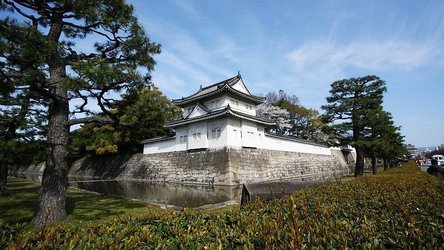
Nijo Castle
(二条城, Nijōjō) was built in 1603 as the Kyoto residence
of Tokugawa Ieyasu, the first shogun of the Edo Period
(1603-1868). His grandson Iemitsu completed the castle's
palace buildings 23 years later and expanded the castle
by adding a five story castle keep.
After the Tokugawa Shogunate fell in 1867, Nijo Castle
was used as an imperial palace for a while before being
donated to the city and opened up to the public as a
historic site. Its palace buildings are arguably the
best surviving examples of castle palace architecture of
Japan's feudal era, and the castle was designated a
UNESCO world heritage site in 1994.
Nijo Castle can be divided into three areas: the Honmaru
(main circle of defense), the Ninomaru (secondary circle
of defense) and some gardens around them. The entire
castle grounds and the Honmaru are surrounded by stone
walls and moats.
Kyoto Tower
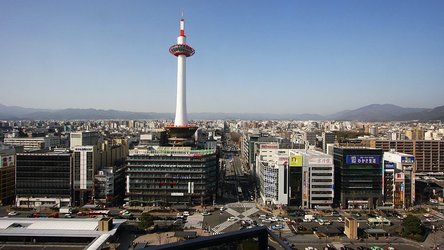
Standing 131
meters tall just across from Kyoto Station, Kyoto Tower
(京都タワー) is Kyoto's tallest structure and a rare modern
iconic landmark in the city famous for its ancient
temples and shrines. The tower was completed in 1964,
the same year as the opening of the shinkansen and the
Tokyo Olympics.
A viewing platform is located 100 meters above ground
and affords a 360 degree view of Kyoto and as far as
Osaka on clear days. Kyoto Tower stands on top of a
typical commercial building, which contains souvenir
shops, restaurants and a hotel. A public bath in the
basement closed permanently in 2021.
Kamo River
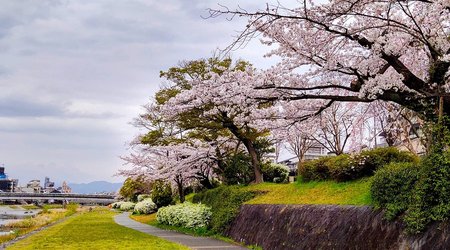
The Kamo River
(鴨川) is located in Kyoto Prefecture, Japan. The
riverbanks are popular walking spots for residents and
tourists. In summer, restaurants open balconies looking
out to the river. There are walkways running alongside
the river, and some stepping stones that cross the
river. The water level of the river is usually
relatively low; less than one meter in most places.
During the rainy season, however, the walkways sometimes
flood in their lower stretches.
It is known for the two Kamo Shrines on its course:
Kamigamo Shrine and Shimogamo Shrine and the shared
Chinju no Mori between them Tadasu-no-mori.
Hanamikoji Street
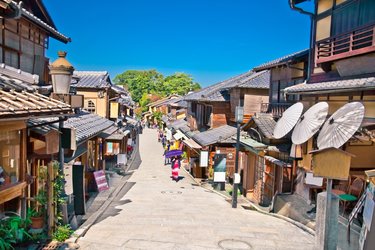
One of the must-visit spots in Kyoto is Hanamikoji Street, located in the Gion district. This 360-meter-long cobblestone street is lined with traditional townhouses featuring distinctive red latticework and wooden fences, capturing the essence of Kyoto’s old-world charm. The street is home to long-established ryotei (traditional Japanese restaurants) and teahouses, some of which date back to the Edo period. If you’re fortunate, you might even catch a glimpse of a maiko or geisha gracefully passing by. During the day, you can enjoy a leisurely stroll and soak in the picturesque scenery, while at night, the street transforms into a magical scene illuminated by lanterns. Hanamikoji Street offers an authentic Kyoto experience and is a must-see on any trip to the city.
Yasaka Shrine
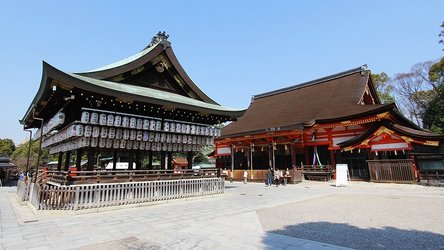
Yasaka Shrine
(八坂神社, Yasaka Jinja), also known as Gion Shrine, is one
of the most famous shrines in Kyoto. Founded over 1350
years ago, the shrine is located between the popular
Gion and Higashiyama districts and is often visited by
tourists walking between the two.
The shrine's main hall combines the honden (inner
sanctuary) and haiden (offering hall) into a single
building. In front of it stands a dance stage with
hundreds of lanterns that get lit in the evenings. Each
lantern bears the name of a local business in return for
a donation.
